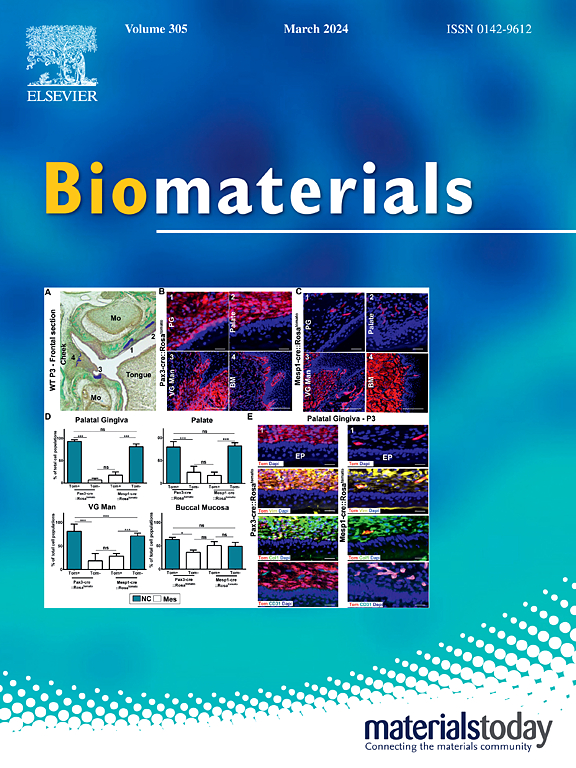多生物活性聚氨基酸-金属-有机框架纳米复合材料增强级联光动力免疫治疗癌症
IF 12.9
1区 医学
Q1 ENGINEERING, BIOMEDICAL
引用次数: 0
摘要
光动力免疫疗法(PDIT)通过产生活性氧(ROS)诱导免疫原性细胞死亡(ICD),是提高癌症免疫治疗疗效的一种有前景的协同方法。然而,PDIT的抗癌效果受到ROS产生不足和高度免疫抑制肿瘤微环境(TMEs)的限制。在本研究中,开发了一种由透明质酸-块聚(1-甲基-d-色氨酸-co-l-谷氨酸)(HA-PMTG)和四羧基卟啉-三价铁(III)金属-有机框架(MOFTCPP-Fe)组成的多生物活性纳米复合材料,用于增强级联PDIT。该纺锤形纳米复合材料HA-PMTG@MOFTCPP-Fe长188 nm,宽80 nm,可被4T1细胞有效摄取,并通过芬顿反应缓解肿瘤缺氧。经静脉注射后,HA-PMTG@MOFTCPP-Fe在小鼠乳腺癌4T1肿瘤中选择性积累长达48小时。激光照射后,光动力治疗(PDT)结合1-MDT对吲哚胺-2,3-双加氧酶(IDO)的抑制成功诱导ICD,导致HA-PMTG@MOFTCPP-Fe组细胞表面钙调蛋白(CRT)阳性增加51.57%。这种增加降低了免疫耐受,抑制了肿瘤生长,并将荷瘤小鼠的中位生存期延长至120天。此外,HA-PMTG@MOFTCPP-Fe对原发肿瘤的治疗通过旁观者效应抑制远处肿瘤的生长,并通过激活免疫记忆防止肿瘤复发。因此,多重生物活性HA-PMTG@MOFTCPP-Fe提供了一种有效的级联策略来提高癌症的PDIT。本文章由计算机程序翻译,如有差异,请以英文原文为准。

Multi-bioactive poly(amino acid)-metal-organic framework nanocomposite for reinforced cascading photodynamic immunotherapy of cancer
Photodynamic immunotherapy (PDIT) represents a promising synergistic approach to enhance the efficacy of cancer immunotherapy by inducing immunogenic cell death (ICD) through the generation of reactive oxygen species (ROS). However, the anti-cancer efficacy of PDIT is limited by insufficient ROS production and highly immunosuppressive tumor microenvironments (TMEs). In this study, a multi-bioactive nanocomposite consisting of hyaluronic acid-block-poly(1-methyl-d-tryptophan-co-l-glutamic acid) (HA-PMTG) and tetracarboxyl porphyrin-trivalent Fe(III) metal-organic framework (MOFTCPP-Fe) was developed for enhanced cascading PDIT. The spindle-shaped nanocomposite HA-PMTG@MOFTCPP-Fe, measuring 188 nm in length and 80 nm in width, demonstrated efficient uptake by 4T1 cells and alleviated tumor hypoxia through the Fenton reaction. Following intravenous injection, HA-PMTG@MOFTCPP-Fe selectively accumulated in mouse breast cancer 4T1 tumor for up to 48 h. Upon laser irradiation, photodynamic therapy (PDT) coupled with the inhibition of indoleamine-2,3-dioxygenase (IDO) by 1-MDT successfully induced ICD, resulting in a 51.57% increase in cell surface calreticulin (CRT) positivity in the HA-PMTG@MOFTCPP-Fe group. This increase reduced immune tolerance, suppressed tumor growth, and extended the median survival of tumor-bearing mice to 120 days. Furthermore, treatment with HA-PMTG@MOFTCPP-Fe on the primary tumor inhibited distant tumor growth through a bystander effect and prevented tumor recurrence by activating immune memory. Thus, the multi-bioactive HA-PMTG@MOFTCPP-Fe offers an effective cascading strategy to enhance the PDIT of cancer.
求助全文
通过发布文献求助,成功后即可免费获取论文全文。
去求助
来源期刊

Biomaterials
工程技术-材料科学:生物材料
CiteScore
26.00
自引率
2.90%
发文量
565
审稿时长
46 days
期刊介绍:
Biomaterials is an international journal covering the science and clinical application of biomaterials. A biomaterial is now defined as a substance that has been engineered to take a form which, alone or as part of a complex system, is used to direct, by control of interactions with components of living systems, the course of any therapeutic or diagnostic procedure. It is the aim of the journal to provide a peer-reviewed forum for the publication of original papers and authoritative review and opinion papers dealing with the most important issues facing the use of biomaterials in clinical practice. The scope of the journal covers the wide range of physical, biological and chemical sciences that underpin the design of biomaterials and the clinical disciplines in which they are used. These sciences include polymer synthesis and characterization, drug and gene vector design, the biology of the host response, immunology and toxicology and self assembly at the nanoscale. Clinical applications include the therapies of medical technology and regenerative medicine in all clinical disciplines, and diagnostic systems that reply on innovative contrast and sensing agents. The journal is relevant to areas such as cancer diagnosis and therapy, implantable devices, drug delivery systems, gene vectors, bionanotechnology and tissue engineering.
 求助内容:
求助内容: 应助结果提醒方式:
应助结果提醒方式:


